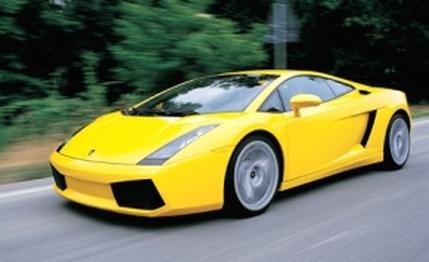
 First Drive Review
First Drive Review
More than anything, it was the 20 gleaming Gallardos lined up at the Vallelunga racetrack near Rome that brought Audi's ownership of Lamborghini into sharp focus. Compare that with the introduction of the first Diablo, way back in 1990, when just one car was rolled out of the storied Sant'Agata factory for our amusement. Yes, just one.
Obviously, it was Audi's deep pockets that made the well-stocked Gallardo launch possible, but there's more than just Audi money in this car. There's an aluminum space-frame body built and painted in an Audi-owned factory. There's a V-10 version of the all-aluminum Audi V-8 nestling just behind the passenger compartment, and there are Audi climate-control panels and switches in the cockpit.
Nonetheless, much of the essential engineering is pure Italian, with Lamborghini's own engine-control electronics directing this 5.0-liter V-10 to its 8000-rpm redline, and the music issuing from the fat stainless tubes poking aggressively through honeycomb mesh in the rear fascia is as Italian as Andrea Bocelli. Lamborghini has a reputation for flamboyant, outrageous car design, so why not use Audi's considerable resources to make everything work?
Why not, indeed? After our group of writers had marveled at the generous array of cars at our disposal and drunk in every plane and contour of the precisely sculpted alloy skin, we climbed in and began to fully appreciate how well the corporate mind meld has worked.
For one thing, the Gallardo's doors open traditionally. None of those wacky guillotine or gullwing portals here-just two doors that swing smooth and wide, providing easy access to firmly supportive Momo bucket seats. The doors close with satisfying thumps, enclosing you in a space that is intimate but not claustrophobic. Despite its pronounced cab-forward stance and wedge profile, this mid-engined coupe actually provides good all-around visibility. So good, in fact, that designer Luc Donckerwolke jokes that they could have made the shape more radical.
No thanks, Luc. It looks just fine, with packaging efficiencies good enough to combine a relatively compact overall size with adequately generous occupant space and enough luggage capacity to accept four made-to-fit bull's-hide bags. A driver with 34-inch trouser inseams can fit in the Gallardo and drive it comfortably.
However, the fat center tunnel might persuade said leggy buyer to check the e-gear option (for a paddle-shift manual with no clutch pedal that costs $9200 in Europe) and forgo the pedal dancing required for those obligatory double-clutch downshifts. You still get the dramatic accompanying soundtrack with the e-gear system. A good thing, since the Gallardo's even-firing V-10 barks a tune that makes the Viper sound like a Shop-Vac.
A short test drive in a Gallardo fitted with the e-gear system-controlled by steering-column-mounted paddles-is all it takes to convince you that Lamborghini got it right. Low-speed shifts slur smoothly from one ratio to another, and even full-throttle, high-rev shifts are accomplished without the slamming violence you often encounter in F1-spec Ferraris.
The automatic throttle blip accompanying downshifts is, of course, there in its throaty glory. It's particularly dramatic when digging for a really low gear, when the system gives a long concerted burst of throttle, bumping engine speed above 7000 rpm if necessary to match revs properly.
Engine performance between shifts isn't bad, either. The V-10 has variable valve timing on all cams and variable-length intake runners, so the torque curve is amazingly flat. The engine supplies 80 percent of its maximum torque from 1500 rpm. That makes the Gallardo extremely easy to drive, with adequate thrust available at almost any engine speed.